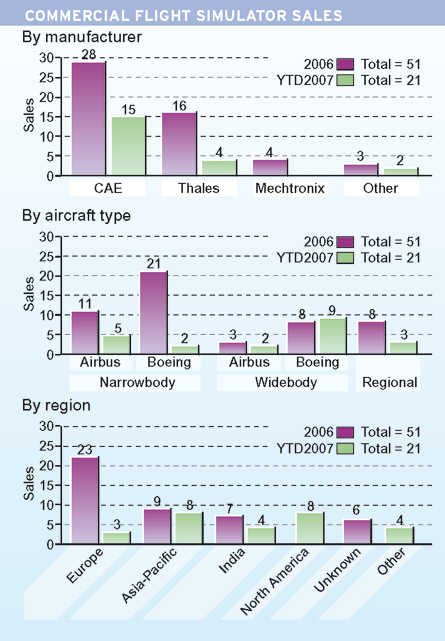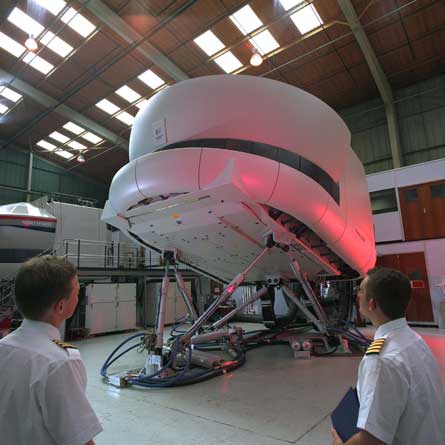Technology is driving the flight simulator market, with the emphasis on cutting costs as manufacturers champion new 'non-zero flight-time' machines
The commercial flight simulator industry is going through one of its periodic technology shifts. Whereas previous cycles have emphasised performance, the driver this time is definitely cost.
Electric motion bases and visual systems combining commercial graphics processors and liquid-crystal projectors are sweeping the market, offering lower purchase and operating costs. The Level D full-flight simulator (FFS) is still the industry standard, but there is a growing market for a lower-level, but still high-fidelity, device tailored to recurrent training.
Montreal-based Mechtronix Systems has championed the concept of the modern "non-zero flight-time" full-motion machine. These lower-cost type-specific devices can be certificated to Level B for recurrent training, but offer similar standards of technology and fidelity to the tail-specific Level D simulators required for zero flight-time initial training.
|
|---|
Hydraulic motion bases are giving way to electric systems that are easier to install and maintain |
After delivering its first such device to Panama's Copa Airlines, Mechtronix received the "stamp of approval" of an order from Lufthansa Flight Training, which placed the Boeing Next Generation 737 simulator into service in Berlin in April following European Level B approval. LFT is using it for customer TUIfly.
A further endorsement of the concept came in March, when market leader CAE launched its 5000 Series simulator aimed at the narrowbody-airliner recurrent training market and focused on the needs of low-cost airlines and third-party training providers. The Canadian manufacturer has so far announced orders for eight such devices: five 737NGs for Ryanair, a 737NG and a Bombardier Q400 for LFT and Embraer Phenom 100 and 3000 business-jet simulators for CAE's training joint-venture with the aircraft manufacturer.
The CAE 5000 is a standardised device with smaller and simpler motion and visual systems to reduce footprint and costs, and is 20-30% cheaper than CAE's latest customised, tail-specific, 7000 Series simulator, says Marc Parent, group president, simulation products. The key to airline acceptance is to reduce cost without sacrificing training quality, Parent says, and the new Level B device runs the same software as a Level D simulator.
What the industry is waiting for is the regulatory environment to catch up with the technology and allow airlines to get training credit for using the complete range of devices available, from desktop trainers to Level D simulators. New regulations would codify the greater training value of a modern "non-zero flight time" simulator compared with a traditional Level B machine. "Level B has been in existence a long time and no-one has done anything with it," says Parent. "Hopefully the regulations will catch up soon."
Sales of these next-generation Level B machines have helped boost the market over the last 18 months. Manufacturer-supplied data indicates that orders for 51 full-flight simulators were placed last year, up from 35 last year and 24 in 2005. This year is off to a strong start, with orders for 21 simulators announced to the end of May. Like others in the air transport industry, CAE's Parent believes the market is in an extended up cycle based on order backlogs at Airbus and Boeing that stretch out for several years at projected production rates.
Simulators for Airbus and Boeing types account for 43 of the orders placed last year and 18 so far this year, with the bulk - 29 and 11 respectively - being for Boeing aircraft. Narrowbody airliners make up the majority of orders as low-cost carriers in Europe and airlines in China and India continue to expand rapidly. The 2006 total includes 21 simulators for the 737NG and 11 for the Airbus A320 family, plus five for the A320 and two for the 737NG this year.
The year to date total includes two FFSs for the Boeing 757 - a narrowbody type now out of production. CAE has not identified the customer, but it could be US cargo carrier FedEx Express, which shelved an order with the Canadian manufacturer for two Airbus A380 simulators when it cancelled its order for the widebody freighter. FedEx is acquiring 90 757s to replace its Boeing 727s.
747-8 freighter
In 2006 CAE sold a Boeing 747-400 freighter FFS to US cargo carrier UPS Airlines, which has also cancelled its order for A380 freighters because of delays. In May, CAE announced the first sale of a simulator for the new 747-8 freighter, to Japan's Nippon Cargo Airlines.
Boeing types - led by the new 787 - make up the bulk of 11 simulator orders in 2006 and 11 this year for widebodies. Boeing training subsidiary Alteon followed up its 2005 launch order with Thales for six 787 training suites with the 2006 purchase of three more, while CAE won its first orders for 787 FFSs - one for China Eastern and two each for Japan Airlines and Qantas.
Delays to A380 deliveries depressed the market for simulators for the ultra-large airliner, with only one order placed in 2006 - by Lufthansa with Thales - and none so far this year. Boeing's 777 continues to do well, however, accounting for four simulator orders in 2006 and three so far this year - split 5:2 between CAE and Thales. Rounding out the widebody market were two FFS orders for the Airbus A330/A340 in 2006 and another two so far this year - all with CAE.
Sales of regional airliner simulators have ebbed in recent years as the North American industry has stagnated, but there is resurgence in emerging markets and - mirroring that for the aircraft themselves - the demand is for turboprops. The eight regional airliner FFSs sold in 2006 include three for the ATR 42/72, with another being booked this year - by Spain's Indra making one of its occasional civil simulator sales, this time to Spanish centre Global Training Aviation.
Embraer market
CAE sold a Bombardier Dash 8 Q400 FFS to Lufthansa earlier this year and Embraer's E-170/190 large regional jet family continues to generate simulator sales: one by CAE in 2006 to Flight Training Finance for use by Panama's Copa Airlines, and one by FlightSafety International this year to Australian low-cost carrier Virgin Blue.

Rounding out the regional market were two key "first of type" deals signed in 2006. Thales was selected to supply three training suites for the Sukhoi Superjet100, formerly the Russian Regional Jet, while CAE struck a deal to build the first FFS for China's large regional jet, the ARJ21, under development by AVIC I Commercial Aircraft. The Superjet100 is scheduled to fly this year, and the ARJ21 in 2008, and their manufacturers want the simulators ready for training before deliveries begin.
Geographically, the market unfolded much as expected. European customers accounted for almost half the simulator orders in 2006, with the big buyers being low-cost carrier Ryanair (six 737NGs from CAE) and independent training centre FSC in Amsterdam (three A320s and four 737NGs from CAE). Lufthansa Flight Training ordered an A320 from CAE, the A380 from Thales and a 737NG from Mechtronix, adding the Q400 this year. Turkish Airlines ordered a Thales A320.
China and India delivered on their promise as rapidly growing markets for training. Indian customers accounted for seven simulator sales in 2006 and four so far this year. CAE's haul includes an A320 and ATR 72-500 for Air Deccan and an A330/A340 and 777-300ER for Jet Airways. Thales booked two A320s and an ATR 42/72 for Kingfisher, and earlier this year announced a deal with new Indian training centre Rudradev Aviation for four FFSs: A320, A330, 737NG and 777-300ER.
Sales to identified Chinese operators tallied up to six in 2006 and four so far this year. CAE sold a 777-300ER to Cathay Pacific, the 787 to China Eastern, an A320 to Shanghai Eastern Flight Training and an A320, A330 and 737NG to its Zuhai Flight Training Centre joint venture with China Southern. Thales booked two 737NGs for Sichuan Airlines. Overall, the wider Asia-Pacific region edged ahead, with a total of nine sales in 2006 and eight (to identified customers) so far this year.
Airlines in North and South America continued to be relatively insignificant buyers, accounting for just three simulator orders in 2006 (a 737NG for Continental, a 777-300ER for Air Canada and the E-170/190 for Copa, all with CAE) and none so far this year. But Parent says there are signs the US market is picking up.
Independent training centres continue to account for a significant slice of simulator sales. In 2006, as well as FSC's expansion, Alteon ordered a 737NG and 777 from Thales (plus the extra 787 FFSs). Alpha Aviation Group secured a 737NG from Sim-Industries for its Bond Aviation Solutions centre in the UK and an A320 from CAE for its Clark Aviation centre in the Philippines, while Sabena Flight Academy ordered a 737NG FFS, also from Sim-Industries.
Tallying up the data supplied by manufacturers gives CAE 28 FFS orders for 2006, and Thales 16. CAE says is has booked 15 orders this year, while Thales has its Rudradev deal. The bullish market gives more opportunity for other manufacturers, and 2006 saw Canada's Mechtronix book orders for four FFSs, Sim-Industries of the Netherlands book two and FlightSafety make one external sale, to Alteon.
The outlook is optimistic. "I think orders will continue at the current pace," says Parent. "Aircraft are being delivered and they require training."
For more news and information relating to Boeing 747 simulators please visit our 747 page
For more news, pictures and information about the Airbus A380 please visit our A380 page
Source: Flight International




















